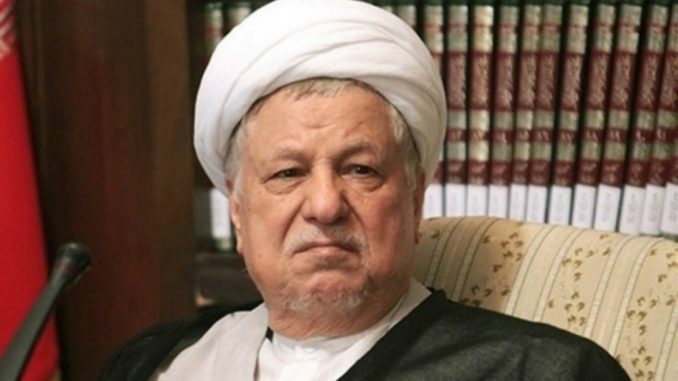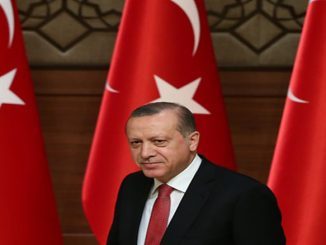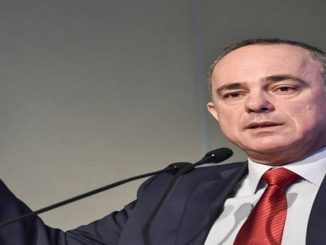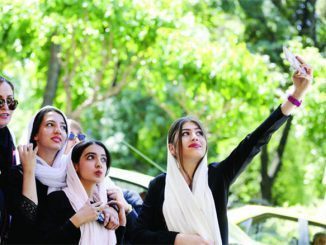
Rafsanjani’s death came in a critical moment for Iran’s reform movement, as he was one of its main backers against the hardliners’ influence. However, many say that he only sought better stability of the cleric’s regime, and no real change that benefits the Iranians.
Rafsanjani, a pragmatist considered Iran’s second most powerful political figure for much of the Islamic Republic’s history, died in hospital in north Tehran on Sunday at the age of 82.
Rafsanjani was a founding member of Iran’s 1979 Islamic revolution that ended the Shah role and brought the clerics’ regime to power. He was a prominent politician after the revolution, and a close person to the former supreme leader Khomeini
When Khomeini died in 1989, Rafsanjani played an instrumental role in the appointment of Ayatollah Ali Khamenei as the current supreme leader.
He served as president for two consecutive terms from 1989 to 1997.
During his leadership, Iran went through an extraordinary transformation as the country focused on post-war construction and industrial revival.
After his presidency, political rivals, jealous of his grip on the economy, seized on his support for reformists and labeled him an “aristocrat,” a “capitalist” and a supporter of “American Islam”, and the rift grew between him and Khamenei.
However, records say that despite these reforming moves he was a criminal who took part in killing thousands of Iranian for the sake of establishing and stabilizing the clerics’ regime. In addition, sources say that his dispute with Khamenei was due to the latter’s monopolization of power.
Rafsanjani’s crimes
According to the National Council of Resistance of Iran (NCRI), Rafsanjani was involved in all the crimes of Khomeini.
During the Iran-Iraq war, Rafsanjani was Khomeini’s de facto deputy and later appointed as commander in chief of the armed forces in the war.
He was responsible for killing of hundreds of thousands of Iranian citizens and dispatching children and young students to mine fields during the war.
After the start of extensive executions in 1981, Rafsanjani repeatedly and formally defended the brutal killings, including once on October 2, 1981, which he stated: “According to God’s commandments 4 sentences to MEK members is binding: 1.to be killed, 2 to be hanged, 3. their hands and feet should be amputated 4. To be separated from the society … “and then said:” if that day (meant the beginning of the revolution) we had executed 200 of them today they were not grown so much. If today we do not firmly stand against these hypocrite groups and agents of America and the Soviet Union, in three years instead of 1,000 people we will have to execute several thousand “(Etelaat daily newspaper October 2, 1981).
Rafsanjani was in charge of the regime’s parliament at the time of Khomeini. Rafsanjani’s greatest crimes in this role weas the participation in the massacre of thirty thousands of political prisoners in 1988, in which he together with Khamenei and Ahmad Khomeini, conveyed Khomeini’s decree to ‘ Death Committee’.
Rafsanjani was a strong supporter of ‘Lajevardi’ the criminal chief of notorious Evin prison who was called ‘the butcher of Evin’ during the 1980s, and in this regard always defended Lajevardi against continuous protests of Mr. Montazeri (Khomeini’s then- heir). In fact, Rafsanjani played a pivotal role in dismissal and house arrest of Montazeri later on.
After Khomeini’s death, Rafsanjani had a leading role in the introduction of Khamenei as Supreme Leader and hold the presidency position for 8 years. But Rafsanjani and Khamenei’s unity did not last long and transformed to a never-ending conflict and power struggle between the two.
Power struggle with Khamenei
Rafsanjani was a member of leadership council since the beginning and took over the leadership of this council after the death of Mullah Meshkini on 2007 to lose it on 2011 in his power struggle with Khamenei.
Rafsanjani never abided the absolute rule of Khamenei and in different occasions had stated that Khamenei was not eligible and didn’t have the necessary qualifications to be the supreme leader and this was the core issue in their animosity towards each other.
After the consequences of the power struggle in 2009 which resulted in a failed uprising, Khamenei, and his band, directly and indirectly, categorized Rafsanjani as the ‘head of the sedition,’ and attacked him.
During the so-called presidential election on 2013, Khamenei managed to disqualify Rafsanjani through his stooge Guardian Council and prevented his candidacy, but inevitably and in fear of another uprising accepted the presidency of Hassan Rouhani, who was regarded a disciple of Rafsanjani.
During recent years Rafsanjani was appeared again as the spiritual godfather of Rouhani and the number two authority in the regime and was established in his role as the head of the expediency Council.
Rafsanjani had a key role in all the assassinations abroad, before and after Khomeini’s death and therefore was condemned by German courts for Mykonos crime and was wanted by the international police and Argentina judiciary for the Buenos Aires bombing which resulted in the death of 86 people.
With the death of Rafsanjani, the regime’s moderation show came to an end and international appeasers lost one of their most favorite celebrities. Rafsanjani’s history on this issue goes back to 1986 secret arms deals between the US, Israel, and Iran when Khomeini was still alive.
Rafsanjani’s death on the verge of upcoming presidential election is considered an important blow to Rouhani and leaves him vulnerable to attacks from rival factions.



